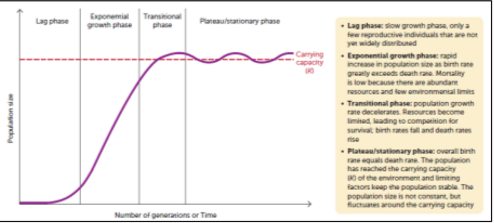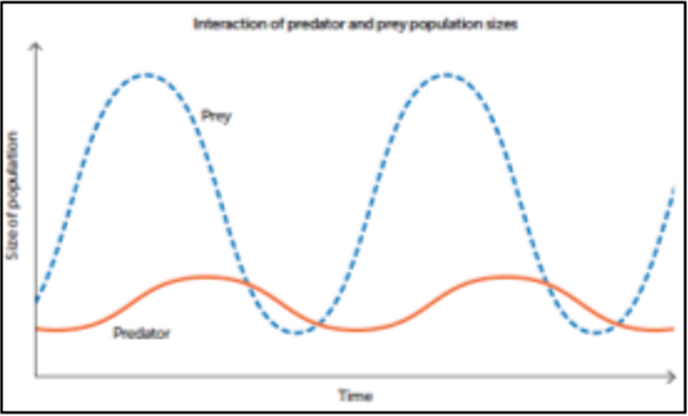Population Dynamic + Succession
1/20
There's no tags or description
Looks like no tags are added yet.
Name | Mastery | Learn | Test | Matching | Spaced |
|---|
No study sessions yet.
21 Terms
Carrying Capacity:
DEF: the long term average number of organisms which an ecosystem can support
Carrying capacity of an ecosystem can change from time to time as environmental conditions change (abiotic and biotic)
Can be increased or decreased due to factors like change in seasons, floods, droughts or introduced species. (can take place over long or short time frames).
Humans influence this process by altering the abiotic (water supply, soil nutrient levels) and biotic (supply of food, reduction of predators). factors
Pop. will grow till limiting factor hinders its growth
Key Note On Carrying Capacity
Habitats have limited resources, so they can only support a certain number of individuals in a population.
Populations rely on balanced relationships between the abiotic and biotic components in their ecosystems.
Limiting Factors : Density Dependent or Independent
NOTE: Pop.’s are limited to the carrying capacity of their environment due to limiting factors.
Density-dependent:
Factors have larger effect on population, when pop. density increases
Often biotic factors including predation, interspecific and intraspecific competition and disease.
Density-independent:
Affect all individuals in the population equally regardless of populations’ density.
Often Abiotic include : severe weather, floods, drought, volcanic eruptions, habitat destruction and hot, intense fires.
S-Curves
When new species colonises a new and favourable area, their pop. increases rapidly.
Continues till resources become limited, pop. density may increase too much and cause disease to spread fast, or increased competition (both types).
Then pop. levels off at the carrying capacity of that ecosystem.
S-curves often created by species with k-selected characteristics.
PHASES:
Lag phase, exponential growth phase, transitional phase and a plateau phase.
for info on graph check page 162 of nelson

J-curves
When a new species colonises a new favourable area their population will increase rapidly. This continues until resources become exploited, causing the population to experience a crash.
Often characterised by species that have r-selected characteristics.
Predator Prey Cycles
Occur when a predator has a reduced number of prey species.
The cycles created when the number of prey increases, it causes the number of predators, and vice versa.

r-selected species
Have characteristics that allow them to exploit environments quickly that have newly become available for colonisation.
Characteristics:
Reproduce rapidly
large numbers of offspring
short life cycles
smaller in size
low levels of parental care for young
Examples:
weed plants, mice, toads, oysters, locusts
K-selected species
Have characteristics that allow them to exist at or close the carrying capacity of their ecosystem.
→ Exist in stable ecosystems.
Characteristics:
Larger
Long life cycles
greater maturity age
few offspring
increased levels of parental care.
Examples:
elephants, whales, oak trees, eucalypts
Changes in Population
Confidence in predictions determined by how representative the sampling is.
Changes in populations occur due to changes in abiotic or biotic factors
Changes in population numbers can be predicted based on surveying techniques and knowledge of the food web.
Ecological succession involves the change of abiotic and biotic factors over time.
Little Note :)
Primary Succession
Beninging:
Begins in lifeless area where soil has not yet formed.
Also can begin in areas after nudation has occurred (when an area has all its organisms removed from it) → usually result from volcanic eruptions, cyclones, earthquakes and tsunamis.
Process:
Pioneer plants like lichens colonise the area and secrete organic acids that weather rock.
Soil formation: a thin layer of soil forms allowing mosses to become established. As lichens die they add nutrient to soil.
Over time bacteria, fungi and invertebrates establish, forming a simple community.
Soil develops and larger plants become established → changes ecosystem further.
R-select species decline due to increased competition levels, as number and range of species increase in the community.
Gradually whole new community forms, colonised by immigrant species from surrounding areas.
As process continues B.D. increases and if no further disruptions encountered, a climax community is established.
Secondary Succession
First:
Natural disturbance such as fire or flood, or by human intervention → logging or land clearing.
Process:
Natural or artificial disturbance occurs.
New plants, such as fast growing r-selected plant species colonise the area.
Slower growing trees begin to grow and stabilise the community.
New herbivores, then carnivores and omnivores arrive and become part of food web.
New community forms and eventually becomes a climax community.
Climax community
DEF: The stable community present at the final stage in a succession.
Tend to be made of slow-growing, long-lived K-selected species.
NOTE:
Not all successions reach a climax community. A combination of factors, such as fire, and selective grazing by herbivores, help allow conditions that support grasslands to persist.
→ These can be known as deflected climax communities
Fire Regimes
DEF:
The fires that a particular ecosystem experiences. Determined by the fire’s frequency, intensity, seasonality and the extent of the area it covers.
What Times/Seasons Best not to Have Fires?
In Summer and during Spring/Breeding season of species.
Results in a greater loss of biodiversity and available habitats when when intense fires occur in summer/dry season
*ALSO:
Should avoid doing it during breeding seasons of most species which occur in the spring months. To maintain biodiversity and support biological population sizes, from decreasing in biodiversity.
→ As reproduction rates would decrease (if done at this time) lowering population sizes decreasing biodiversity.
Frequency of Fires and Having Ideal Frequencies
2 Key Points:
Infrequent fires will be more intense due to increased fuel loads, of leaf litter on surface of ground in forests/woodlands.
Fires can promote native fire intolerant species and decrease invasive plant species if they occur at ideal frequencies.
Too Infrequent
Fire tolerant species need fire/heat to complete life cycles.
If fire is too infrequent, seeds will be produced and adult individuals will die.
Seeds will not have the opportunity to germinate and them become unviable/decompose.
Non-tolerant species will have opportunity to complete life cycles and outcompete the fire tolerant species.
Too Frequent
Fire tolerant species need time to grow, mature and produce seeds as part of their life cycle
A fire can occur and remove mature fire tolerant species and cause their seeds to germinate.
A second fire occurs soon after and removes recently germinated fire tolerant species before they have produced seeds.
The fire tolerant species becomes locally “extinct” and completely removed from that ecosystem.
Benefits of Fire
Fire recycles nutrients from the biotic components, turning them back into abiotic components
Fire allows plants that require fire for their seeds to germinate. (e.g. Banksia)
Reduces fuel load in the environment reducing the risk of catastrophic fires.
Detriments of Fire:
Fires can decrease the organic matter in the soil, particularly if they are very hot.
Reduces possible habitats for animals.
Increases death from predators like cats due to lack of habitats.
Increase green house gas concentrations in atmosphere like CO2.
Mosaic Burning
Def: Burning smaller sections within a larger ecosystem, in a patchwork pattern.
Smaller fires within a larger ecosystem creates a mosaic of areas at different stages of ecological succession
By having all the diff stages of ecological succession present in the the entire larger ecosystem, the entire range of plants and animals that exist in each of those stages will be present.
Because a larger range and number of species are present the biodiversity increases.